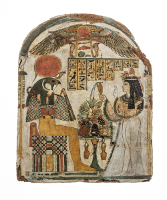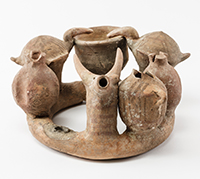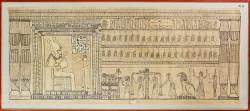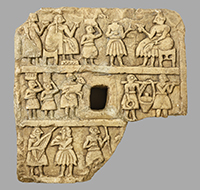Highlights from the Collection: Ritual Objects
Funerary Stela
Found in the Ramesseum at Thebes, this painted funerary stela was erected to commemorate the lady Djed-Khonsu-es-ankh. The deceased woman, in a diaphanous white gown, wears a cone of perfumed beeswax and a water lily on her head. She pours a libation over a table of food offerings and raises her hand to greet the seated god Re-Harakhty, a form of the ancient Egyptian sun god. The hieroglyphic signs offer a prayer asking the gods to supply food and drink for the survival of her spirit in the netherworld.
The inscription, a standard offering formula, reads:
An offering which the King gives to Re-Harakhty, the Great God, Lord of Heaven, that he may give invocation-offerings consisting of offerings and food to the Osiris, Lady of the House, the noblewoman, Djed-Khonsu-es-ankh, deceased, daughter of the priest of Amun-Ra, King of the Gods, Master of the Secrets of the Garments of the Gods, Ser- Djehuty.
Kernos Ring
This ring was probably used as a libation vessel during religious ceremonies in ancient Palestine. It consists of a hollow clay ring with hollow clay attachments in the forms of a gazelle head, two jars, two pomegranates, two doves, and a cup. The doves, whose heads have been restored, drink from the cup. An eighth attachment is missing, having been broken off in antiquity.
The pomegranate, the gazelle and the doves suggest that this ring was associated with a fertility cult. Wine or water would have been poured into the cup and circulated through the other objects attached to the ring, thus symbolizing the fertility of the earth and its produce.
Kernos rings are fairly common in Palestine, although few are as elaborate or as well preserved as this one.
Book of the Dead
The Book of the Dead was a collection of spells, hymns, and prayers intended to secure for the deceased safe passage to and sojourn in the other world. The sections of papyrus on display to the left and right are from one of these long scrolls, which was cut into fifteen sections in modern times.
The illustration to the left shows the judgement of the soul before Osiris, the god of the dead, who determines the deceased's worthiness to enter the next life by assessing his earthly deeds. The heart of Yartiuerow (the deceased) is being weighed in the balance against the feather of the goddess Maat, representing truth and justice. The jackal-god Anubis tips the balance in Yartiuerow's favor while the falcon-headed god Horus looks on and the ibis-headed Thoth, the secretary of the gods, records the favorable verdict. Yartiuerow himself stands on the right, his hands raised in jubilation, accompanied by the goddess Maat. Before him is a monster-part hippopotamus, part crocodile, and part lion- which would have annihilated him had the judgement been unfavorable.
The title of the Book of the Dead and its method of use are stated in the horizontal line at the top of the section exhibited to the right: "Beginning of the spells for going forth by day which raise the glorious ones (i.e., the dead) in the cemetery. To be said on the day of burial of entering in after going forth, by Osiris Yartiuerow, deceased." The vignette below shows part of the funeral procession. The sledge bearing the coffin is drawn by oxen. Two smaller sledges, each drawn by a man, follow. The one behind the coffcin bears the canopic box containing the four jars in which the viscera were preserved. On its lid lies a figure of the mortuary god Anubis in jackal form.
Pair of Bull Statuettes
 These two bulls probably once adorned the top of a royal or divine standard (or the tops of a pair of such standards). The treatment of their surfaces is unusual-one half of each bull was covered with what may be a copper-arsenic plating (probably originally silver in color), the other half with copper. While the copper surface has become corroded, the portion covered with the arsenical metal remains essentially intact.
These two bulls probably once adorned the top of a royal or divine standard (or the tops of a pair of such standards). The treatment of their surfaces is unusual-one half of each bull was covered with what may be a copper-arsenic plating (probably originally silver in color), the other half with copper. While the copper surface has become corroded, the portion covered with the arsenical metal remains essentially intact.
Sumerian Statuette
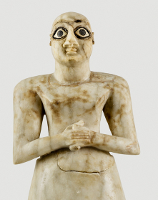 During the Early Dynastic Period in Mesopotamia, statuettes were placed in sanctuaries as votive offerings and were later buried when the temple was remodelled or rebuilt. This representation of a Sumerian standing reverently before his god is one of a group of sculptures found buried in a pit next to the altar of the Abu Temple at Tell Asmar. It is thought to depict a priest because it lacks the full beard and long hair of other male statues of its type.
During the Early Dynastic Period in Mesopotamia, statuettes were placed in sanctuaries as votive offerings and were later buried when the temple was remodelled or rebuilt. This representation of a Sumerian standing reverently before his god is one of a group of sculptures found buried in a pit next to the altar of the Abu Temple at Tell Asmar. It is thought to depict a priest because it lacks the full beard and long hair of other male statues of its type.
Banquet Plaque
The top register of this plaque shows a seated man and woman celebrating an unidentified event or ritual by participating in a banquet. Two servants attend them while others bring a jar (probably filled with beer), an animal to be slaughtered, and other edibles carried in bundles on their heads. Musicians and dancers in the bottom register add to the festivities.
Plaques such as this were part of a door-locking system for important buildings. The plaque was embedded in the doorjamb and a peg, inserted into the central perforation, was used to hold a hook or cord that secured the door and was covered with clay impressed by one or more seals.
Four-Horned Incense Altar
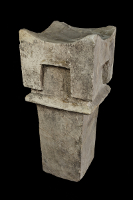 Horned altars are described in the Bible and have been discovered at many Iron Age Israelite sites. This example is probably too small to have been used for animal sacrifice, but may have served for the other three types of offerings known to have been made: wine, incense, and grain meal mixed with oil. The Megiddo stratum in which this altar was found was characterized by large public structures and is generally thought to have been built by King Solomon. It included a four-entryway gate and a well-built double or "casemate" wall.
Horned altars are described in the Bible and have been discovered at many Iron Age Israelite sites. This example is probably too small to have been used for animal sacrifice, but may have served for the other three types of offerings known to have been made: wine, incense, and grain meal mixed with oil. The Megiddo stratum in which this altar was found was characterized by large public structures and is generally thought to have been built by King Solomon. It included a four-entryway gate and a well-built double or "casemate" wall.

